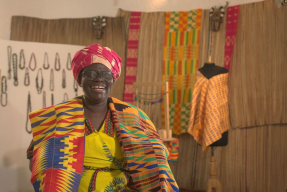By Rob Packer, KF10 Colombia
Sometimes context is everything. If you met someone making muesli, granola and other fibre products in San Francisco or Berlin, you might not be all that surprised. But if you take away the context of coffee culture, media types and brunch and replace it with Barranquilla, a port town with an image problem on Colombia’s Caribbean coast, things start looking different. Oh, he’s also a microfinance borrower. Not exactly what you’d expect.
Earlier in the week, I took a trip with a loan officer from FMSD to meet Gustavo in Me Quejo—incidentally I’d been looking forward to a trip to this barrio since I arrived as it means “I complain” which makes it my favourite barrio name in all Barranquilla (see here for more background). Gustavo is one of the most unique Colombians I’ve met in my months here: in a land of meat, rice and soup, he’s been a vegetarian for the past thirty years. He gave up selling products like shampoo seven years ago and used his understanding of vegetarian food to start a natural food business with little more than a casserole dish and a great idea. Years later, Gustavo’s business is still small and based in one room, and he’s found a market selling his products to vegetarian restaurants and natural food shops—I had no idea these existed in Barranquilla either. But what really set him apart for me were his ambitions to expand the brand he’s created to break into supermarket chains and to start selling his products in gyms in Barranquilla. I was struck that this was 1) an excellent idea and that it was 2) achievable if he has access to the capital required. If he achieves his dreams (and I hope he does) it would be yet another example of the interplay between formal and informal economies that characterizes so many developing countries and the juxtaposition of rich and poor that’s more marked in Latin America than other regions: it’s these differences that I find one of the most disorienting aspects of living in the developing world.
As we left I took a moment to think about a bizarre intersect that I never thought I’d see: Whole Foods and microfinance. There was part of me that was stunned by the fact that a microfinance borrower was working in the health foods business, an industry often associated with overpriced snobbery. And then I realized that I was looking at things from my own cultural context and not seeing the bigger Colombian picture and realized that Gustavo was one of those microfinance entrepreneurs we all love to read about: someone with an innovative idea who only had the resources to get it off the ground with microcredit.
And at the end of the day, isn’t this what microfinance and Kiva is all about? It’s about giving these people the chance to grow their businesses.
Rob Packer is a Kiva Fellow currently working with the Fundación Mario Santo Domingo in Barranquilla, Colombia. There are borrowers from Colombia with FMSD who you can help by contributing to a loan today, and many other entrepreneurs from around the world on the Kiva site.
PREVIOUS ARTICLE
Kiva Quotes of the Week →NEXT ARTICLE
Reminder: Early Bird Registration for Empowering Women Through Microfinance Discussion ends 4/1! →
















